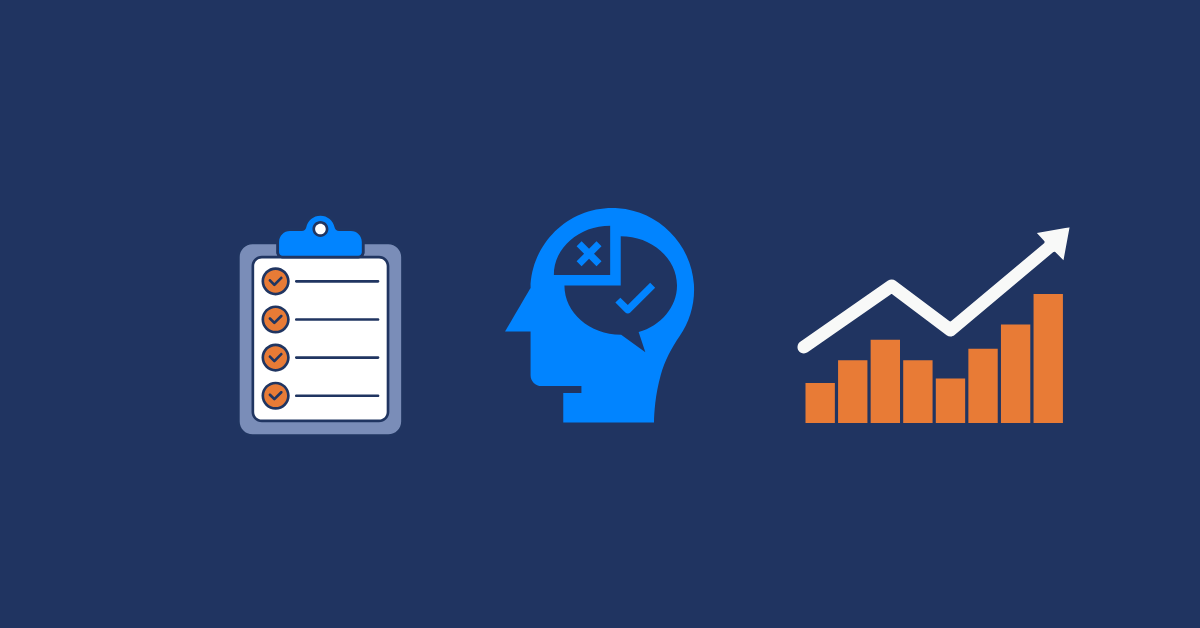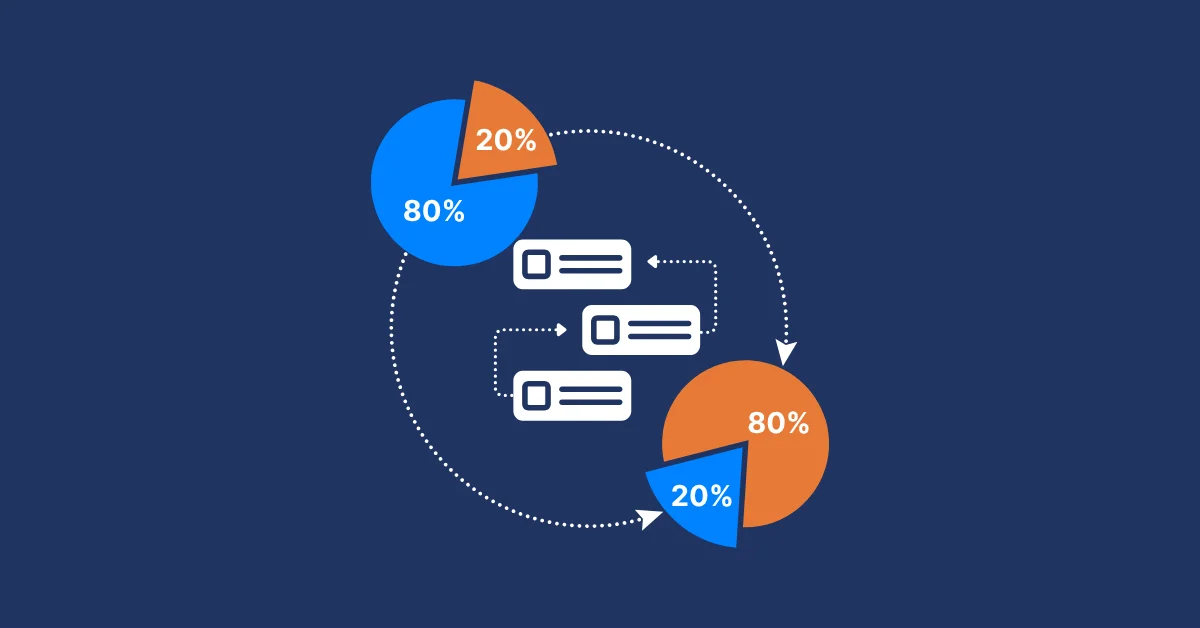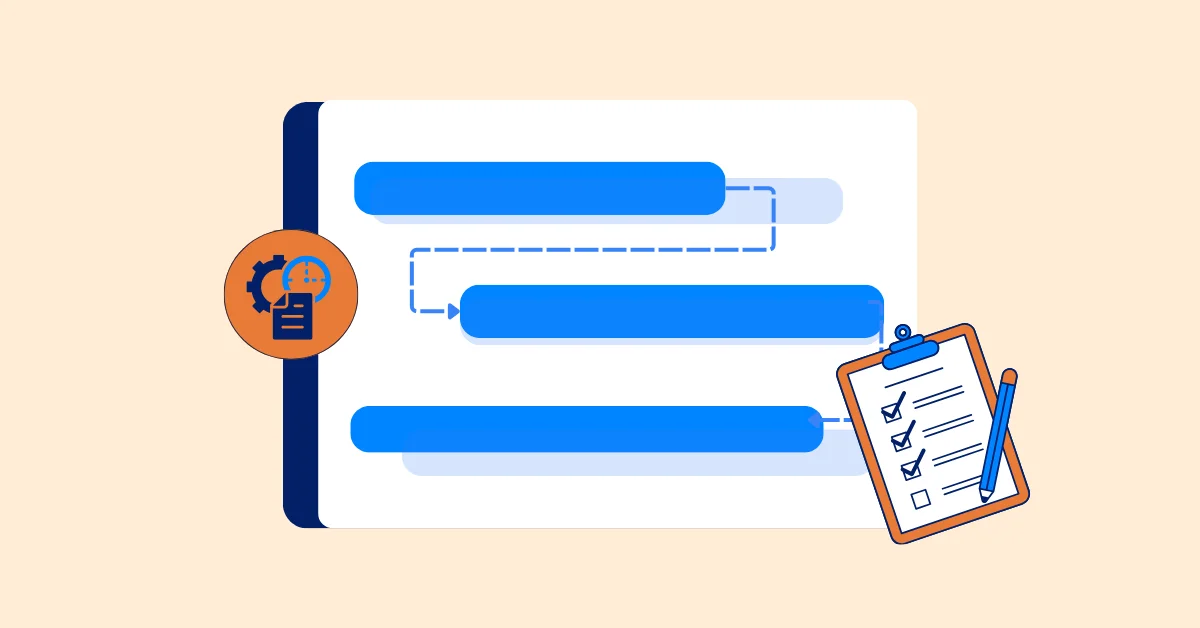The Essentials of Project Evaluation: Steps, Methods, and Elements
Discover the key steps, methods, and frameworks of project evaluation to measure performance, improve decision-making, and ensure long-term project success.
Every project manager knows that success involves more than delivering outputs on time and within budget. The true measure of success lies in understanding how effectively a project achieved its intended goals. This is where project evaluation plays a critical role.
Project evaluation is the systematic assessment of a project’s design, implementation, and outcomes. It helps organizations identify strengths, weaknesses, and lessons learned. In project management, evaluation is not a final step but a continuous process that promotes accountability, learning, and improvement. This article will explore the process, methods and elements that make an effective project evaluation, along with key frameworks that enhance it.
Why Project Evaluation Matters
A well-conducted evaluation allows teams to make informed decisions, allocate resources wisely, and demonstrate the value of their work. Its project management benefits fall into four main categories.
- Accountability: Evaluation provides transparency by showing how resources were used and what results were achieved. It helps justify investments to stakeholders and funders while maintaining credibility.
- Learning and Improvement: By identifying what worked and what did not, teams can refine future projects. Evaluation helps prevent repeated mistakes and builds a culture of continuous improvement.
- Decision Support: Evaluation data supports key decisions such as scaling up a project, modifying strategies, or discontinuing ineffective activities. Evidence-driven insights lead to smarter management choices.
- Strategic Alignment: Every project should align with broader organizational goals. Evaluation ensures that the project’s outcomes contribute to long-term strategy and measurable impact.
The Project Evaluation Process
The evaluation process provides structure and consistency, ensuring that findings are accurate and actionable. A comprehensive process generally involves six key steps.
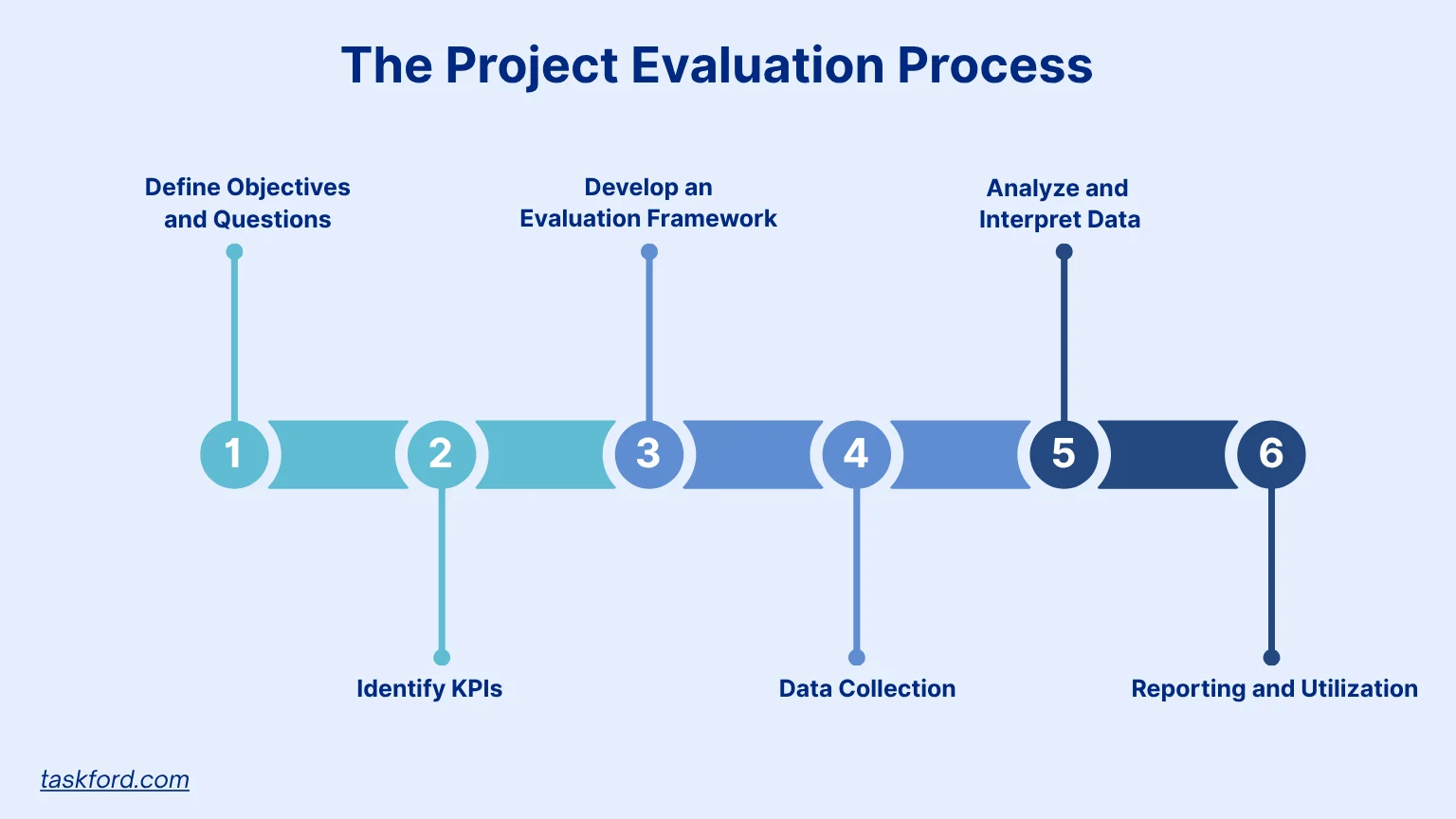
Step 1: Define Objectives and Evaluation Questions
Every evaluation starts by clarifying its purpose. Is the goal to assess effectiveness, efficiency, sustainability, or impact? Once the purpose is clear, evaluators develop guiding questions such as:
- Were project objectives achieved?
- How effectively were resources managed?
- What external factors influenced results?
Well-defined objectives and questions keep the evaluation focused and relevant.
Step 2: Identify Key Performance Indicators (KPIs)
Next, select indicators that translate goals into measurable terms. Indicators can include:
- Quantitative: budget variance, completion rate, number of beneficiaries served
- Qualitative: stakeholder satisfaction, perceived usefulness, behavioral change
Choosing a balanced mix of indicators ensures that both measurable outputs and intangible outcomes are captured.
Step 3: Develop an Evaluation Framework
A framework organizes how data will be collected, analyzed, and interpreted. This includes defining:
- Evaluation criteria (e.g., relevance, effectiveness, impact)
- Data sources (project reports, surveys, observations)
- Tools and methods (questionnaires, focus groups, analytics platforms)
A clear framework improves consistency and comparability across projects.
Step 4: Data Collection
Data collection must be systematic and aligned with ethical standards. Methods include:
- Document review: project proposals, reports, budgets
- Field research: interviews, focus groups, site visits
- Quantitative analysis: KPIs, metrics dashboards, cost tracking
- Observation: monitoring team meetings or project delivery in real time
Combining multiple methods helps triangulate findings for accuracy.
Step 5: Data Analysis and Interpretation
Data analysis transforms raw information into insight. Quantitative data reveals trends and efficiency patterns, while qualitative data explains why certain outcomes occurred. Common techniques include:
- Statistical comparison to baseline data
- Thematic coding of interviews
- Correlation analysis to explore relationships between activities and outcomes
Interpretation should always link findings back to the original evaluation questions and objectives.
Step 6: Reporting and Utilization
An evaluation’s value depends on how its results are used. Reports should be clear, visual, and actionable, summarizing:
- Key findings and conclusions
- Recommendations for improvement
- Lessons learned and next steps
Finally, ensure feedback loops so that insights feed into planning, budgeting, and future decision-making. Evaluation is only complete when findings lead to real organizational learning.
Five Key Methods of Project Evaluation
Different stages of a project require different types of evaluation. The following five methods represent the most practical and widely applied approaches in project management.
1. Pre-Project Evaluation (Ex-Ante Evaluation)
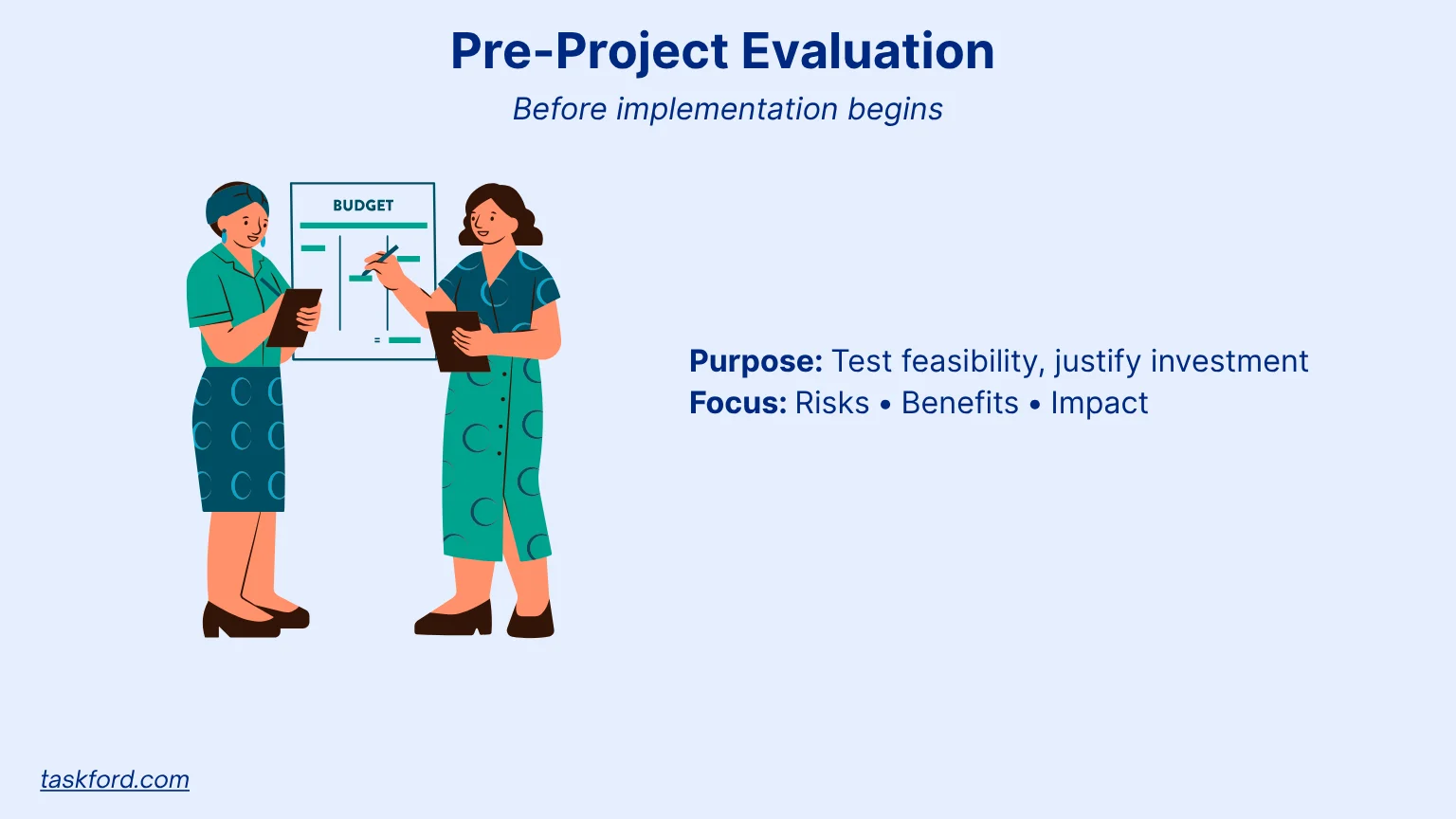
When to use it: Before implementation begins. Purpose: To determine feasibility and justify investment. Focus: Risks, projected benefits, and potential impact.
This method helps organizations decide whether a proposed project should move forward. Evaluators analyze needs, goals, and expected outcomes to confirm that the project is worth pursuing.
Typical tools include:
- Feasibility studies
- Cost-benefit analysis
- Stakeholder assessments
- Risk identification matrices
Pre-project evaluation ensures that resources are directed toward initiatives with strong justification and achievable outcomes.
2. Formative Evaluation
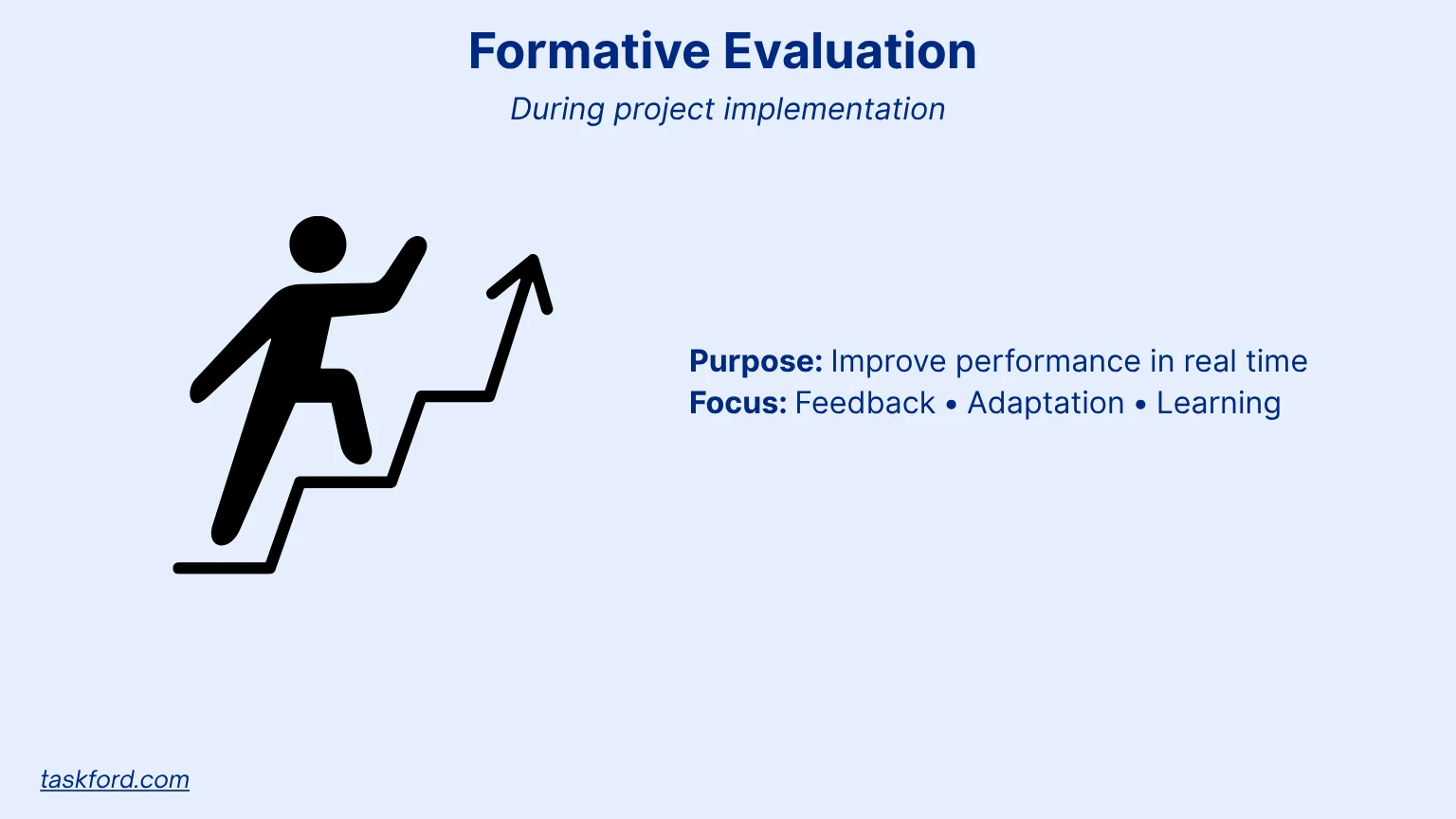
When to use it: During project implementation. Purpose: To improve performance in real time. Focus: Ongoing feedback and adaptive learning.
Formative evaluation helps teams identify emerging challenges and make immediate adjustments. For instance, if delays or inefficiencies are detected, managers can reallocate resources or modify processes before the project ends.
It often involves regular check-ins, internal reviews, and progress tracking reports that allow project managers to learn and adapt continuously.
3. Process Evaluation
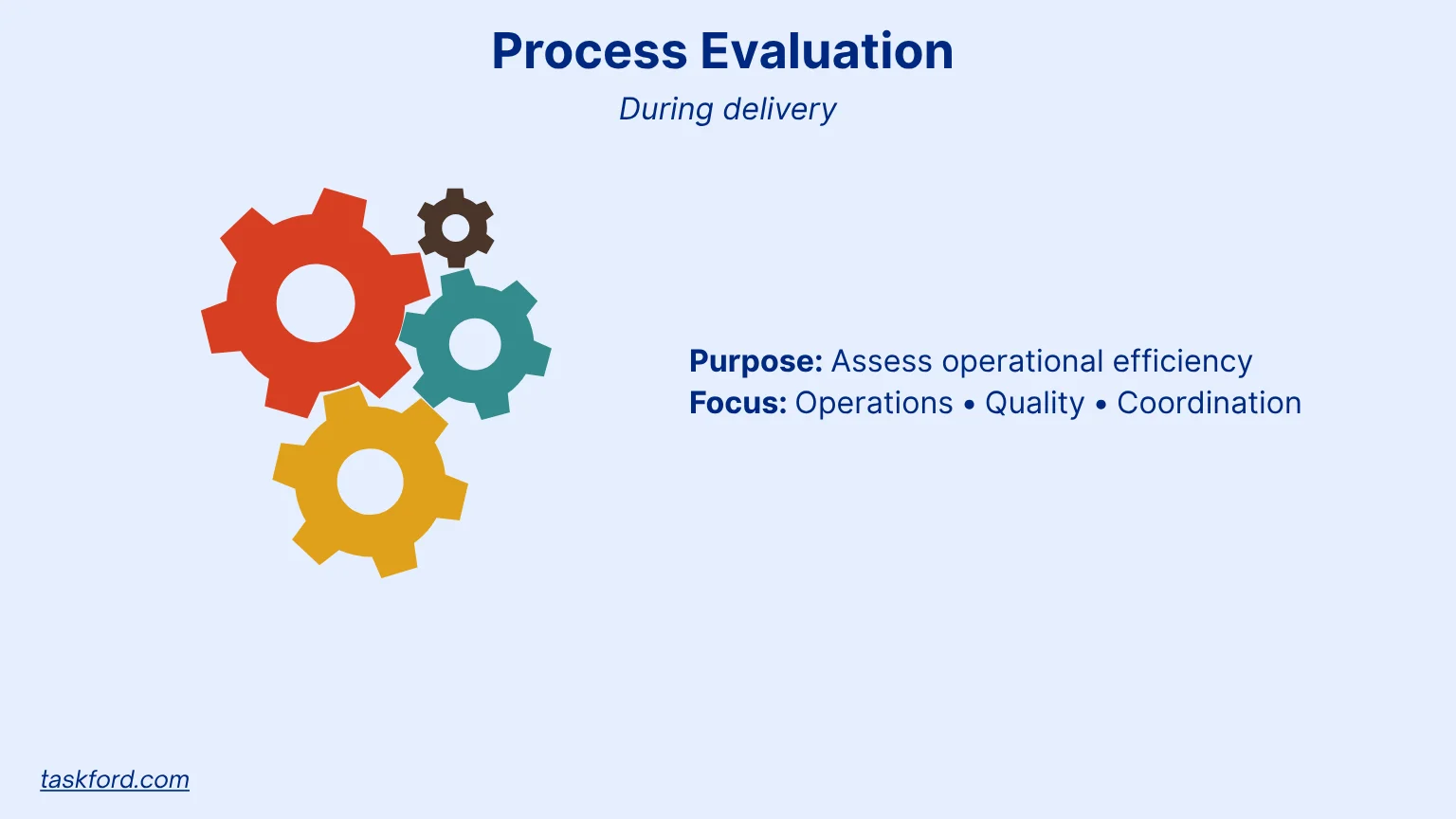
When to use it: While activities are being delivered. Purpose: To assess operational efficiency. Focus: Implementation quality and management systems.
Process evaluation examines whether the project is being executed as planned. It investigates:
- Whether activities align with objectives
- How well resources are utilized
- How effectively teams communicate and coordinate
This method identifies bottlenecks or procedural issues that may hinder performance. By focusing on internal operations, process evaluation helps organizations strengthen management practices and accountability.
4. Summative Evaluation
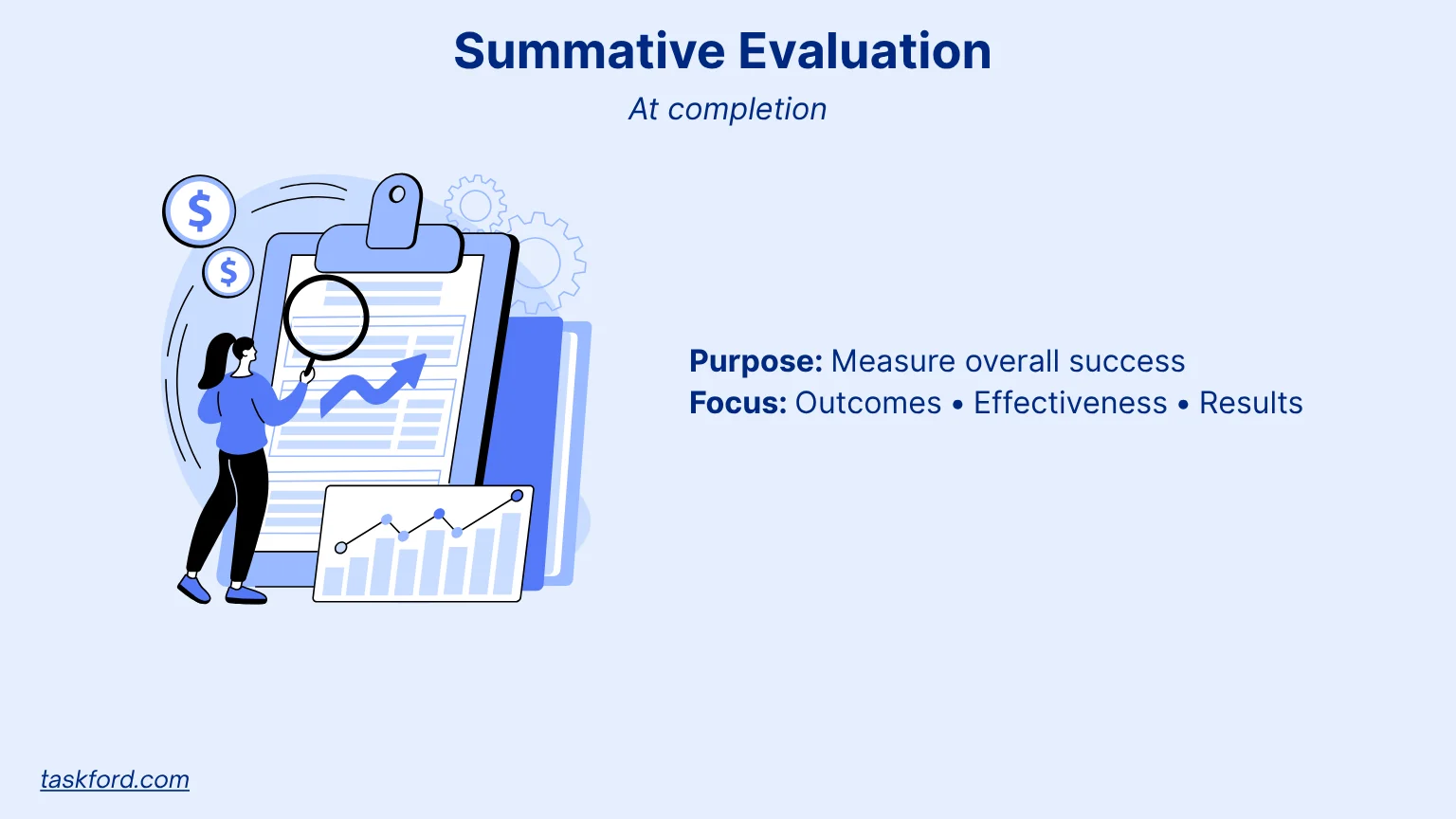
When to use it: At the project’s completion. Purpose: To determine the project’s overall success. Focus: Results, effectiveness, and achieved outcomes.
Summative evaluation provides a final assessment of how well the project met its objectives. It measures tangible outcomes such as productivity gains, cost efficiency, or social impact.
The findings are often presented to funders, executives, and stakeholders to demonstrate value and justify continuation or expansion. Summative evaluation also informs future planning by highlighting which strategies were most effective.
5. Post-Project Evaluation (Ex-Post Evaluation)
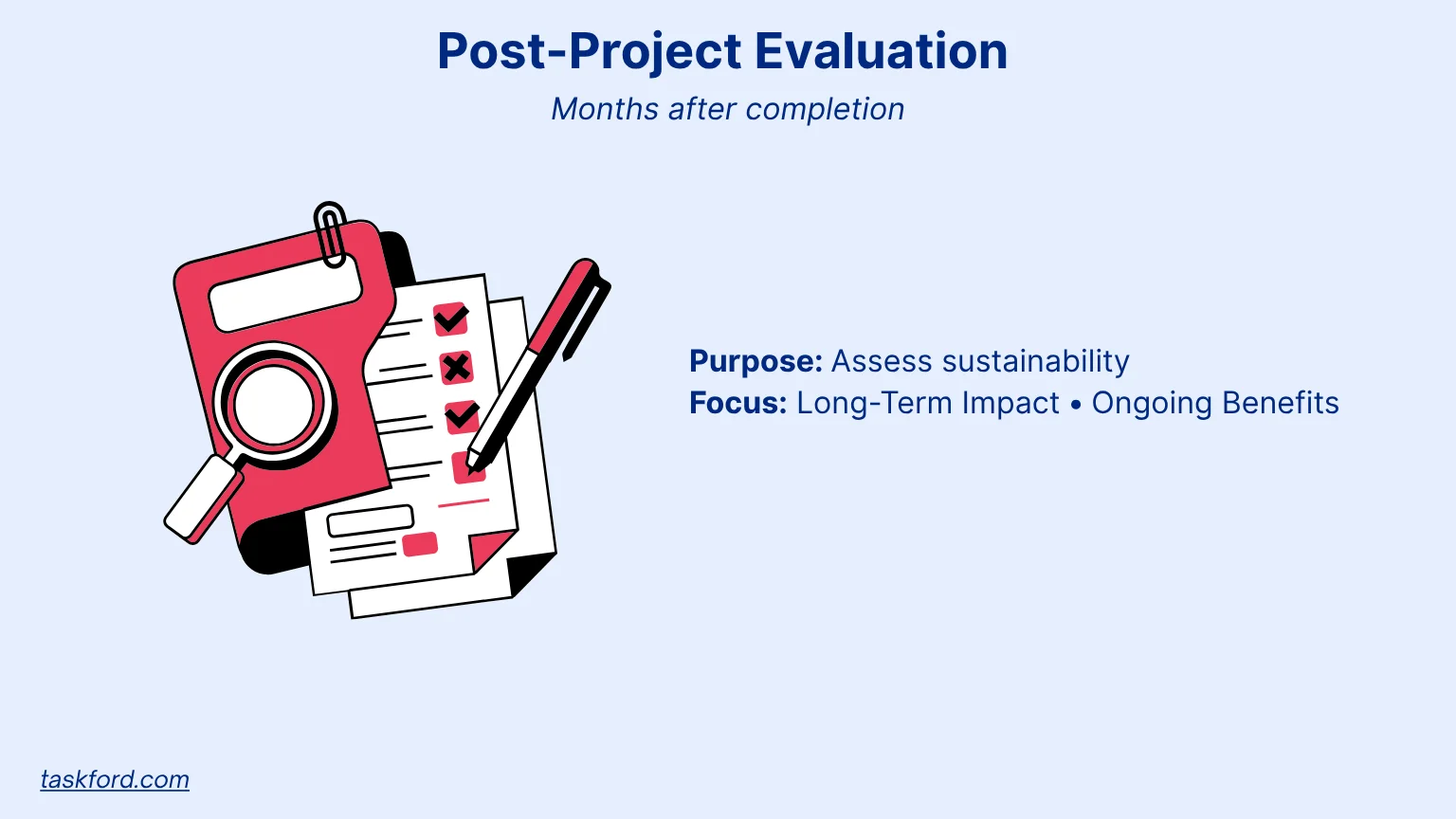
When to use it: After project completion (often 6–24 months later). Purpose: To evaluate sustainability and long-term impact. Focus: Continued benefits and systemic change.
Post-project evaluation assesses whether results are maintained over time. It examines the durability of benefits and whether the project continues to have a positive effect on its target community or organization.
For example, in a skills training project, evaluators might check whether participants still apply what they learned a year later. This method provides powerful evidence about sustainability and long-term success.
Five Common Frameworks and Analytical Tools for Project Evaluation
Evaluation frameworks guide how data is collected, analyzed, and interpreted. The following five are widely used because they bring structure and consistency to the evaluation process.
1. Logical Framework Approach (LFA)
The Logical Framework Approach is one of the most common tools in project evaluation. It organizes a project into a hierarchy of inputs, activities, outputs, outcomes, and impacts. Each level has specific indicators that track progress and measure success.
Using LFA ensures that every project component connects logically to broader goals. It helps teams visualize how resources translate into measurable results.
2. Theory of Change (ToC)
The Theory Of Change outlines how and why a project is expected to produce certain outcomes. It describes the causal pathway from activities to results and identifies assumptions that may affect success.
This framework is particularly valuable for complex or social-impact projects. It clarifies expectations, reveals external influences, and helps evaluators understand whether observed changes align with the project’s original logic.
3. Results-Based Management (RBM)
Results-Based Management focuses on achieving measurable results instead of merely completing activities. It uses performance indicators and periodic measurement to track progress throughout the project lifecycle.
RBM emphasizes accountability for outcomes. It links individual tasks to strategic objectives, making it easier to show how project activities contribute to organizational performance.
4. Cost-Benefit Analysis (CBA)
Cost-Benefit Analysis compares total expected costs with total expected benefits, often expressed in monetary terms. It helps determine whether a project offers sufficient value relative to its investment.
CBA is frequently used during pre-project evaluations to support funding decisions. It allows organizations to compare multiple project proposals objectively and choose those with the highest potential return.
5. Impact Evaluation
Impact evaluation measures the actual difference a project makes compared to what would have occurred without it. It uses quantitative techniques such as control groups or counterfactual analysis to assess attribution.
This framework is ideal for projects with measurable social, economic, or environmental outcomes. It helps organizations understand the real change they have achieved and provides evidence for policy recommendations or scaling decisions.
Core Elements of an Effective Project Evaluation System
A strong evaluation system is built on several key elements that ensure reliability, relevance, and learning.
- SMART Indicators: Indicators should be Specific, Measurable, Achievable, Relevant, and Time-bound. These provide clear benchmarks for tracking progress objectively.
- Baseline and Benchmarking: Establishing baseline data at the start of a project allows for comparison later. Benchmarking against industry standards or similar projects provides valuable context.
- Stakeholder Engagement: Engaging stakeholders throughout the evaluation process enhances credibility and inclusiveness. Their input provides practical insights and helps ensure the findings are relevant and accepted.
- Data Integrity and Transparency: Accurate data and transparent documentation are vital. Evaluations should clearly explain data sources, collection methods, and limitations to maintain trustworthiness.
- Feedback Loops: Evaluation findings must feed back into planning and decision-making. Continuous feedback helps refine strategies, allocate resources better, and strengthen organizational learning.
Challenges and Best Practices during Project Evaluation
Common Challenges
Project evaluation often faces several barriers:
- Limited or unreliable data
- Unclear objectives or evaluation criteria
- Time and budget constraints
- Minimal stakeholder participation
- Difficulty translating results into actionable insights
Best Practices
To overcome these challenges, organizations can:
- Integrate evaluation activities into every stage of the project lifecycle
- Use both quantitative and qualitative methods for richer insights
- Apply ethical standards when collecting and reporting data
- Use digital tools such as dashboards for real-time performance tracking
Tips: TaskFord is a comprehensive project management and resource planning platform that provides tools to help teams of all sizes monitor project and tasks progress, providing data to enhance project evaluation
- Foster a culture that values reflection, accountability, and continuous learning
These practices transform evaluation from a compliance exercise into a genuine learning opportunity.
Conclusion
Project evaluation is an essential component of effective project management. It ensures accountability, measures impact, and supports continuous learning across all stages of the project lifecycle.
By using the right evaluation methods and applying structured frameworks, organizations can make smarter decisions and deliver lasting results. When applied consistently, project evaluation turns data into insight and experience into improvement. It enables teams not only to measure success but to understand it, replicate it, and build on it for greater impact in the future.
Learn more
- Will AI Replace Project Managers? Separating Hype from Reality in 2025's AI Project Management Landscape
- What is Project Management: A Beginner’s Comprehensive Guide 2025
- A Day in the Life of a Project Manager: How They Bring Projects to Life
Making work simpler,
smarter, and more connected
Join our waitlist and be notified first.

Related Blog
Subscribe for Expert Tips
Unlock expert insights and stay ahead with TaskFord. Sign up now to receive valuable tips, strategies, and updates directly in your inbox.

